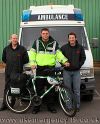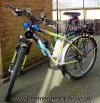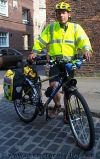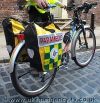Category: Ambulance Cycles
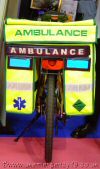
This picture shows two flashing blue lights and a flashing ambulance sign on the rear of a London ambulance bike. What is interesting is the fact that they are paper thin and are made of material. They run on a separate small pack of batteries and can run continuously for weeks.
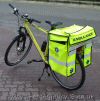
A similar pannier box can be seen on the back of this St John Ambulance London District Cycle Response unit.
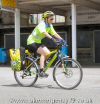
Here is EMT Kate Walker on a training course before becoming a fully fledged TENYAS life-cycle rider and emergency responder.

This black Smith & Wesson paramedic cycle is liveried as London Ambulance Service, but is actually a sample in use at a display of medical equipment.

Here is another St. John ambulance cycle. It has a large oxygen cylinder placed horizontally behind the seat, and two further panniers which include an AED (automated external defibrillator).

Here is a ‘Medicman’ cycle unit that is used to provide cover at large outdoor events. ‘Medicman’ is a private company that provides medical cover and training.

Tees, East and North Yorkshire Ambulance Service’s Life-Cycle team expanded in June 2004 with the introduction of two more reserve riders. In the centre is Technician Kate Walker who is the first female ambulance cyclist outside of London. She is joined on the right by Technician Neil Green. The extra manpower allows cover to be maintained 12 hours per day, every day of the year in York city centre. On the left of the picture is founding Life-Cycle paramedic Mark Inman.

Ian Gregory, a Dorset Ambulance Service paramedic, on a training course prior to the launch of a two-paramedic cycling ambulance service unit. They will respond to emergencies in Bournemouth town centre and along the sea front.

In April 2004 one TENYAS life-cycle was equipped with a large high-visibility yellow pannier in the same style as LAS’s cycles (see below). The pannier box is embroided with the life-cycle logo and has large ‘ambulance’ signs on all sides. It has reflective striping to the rear and a clear map case on the top flap.

This photograph shows the two packs of medical equipment that slide out of the pannier box, along with the oxygen cylinder. This revised design means that the cycle is highly visible whether the medical equipment is in use or not.

This photo shows London Ambulance Service paramedic Sean Clarke on a emergency cyclists training course in York.
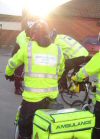
The rear view of colleague Claire Tinker’s ambulance cycle. Notice the ‘pizza delivery box’ style pannier, the map case built into the top and her halo!

TENYAS paramedic Mark Inman practices heavy braking in response to a shout from instructor Monte May.

This is one of St. John Ambulance’s medi-bikes. Operated by the Halifax & Brighouse division, they are recognised as the first SJA cycle response team in the UK.
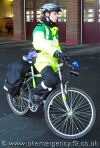
A wider view of the bike and rider showing the blue lights, white lights, siren and panniers

In August 2003 the TENYAS life-cycle team was expanded from one to four paramedics. For the previous two-and-a-half years, one paramedic has been working eight hours per day, five days per week. With the additional man-power, the unit will operate for twelve hours per day, seven days per week. Pictured (from left to right) are Mark Inman, Martin Dodd, Neil Roberts and Andy Church.
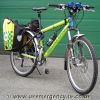
The re-liveried (August 2003) third life-cycle.

TENYAS paramedic Paul Brown carefully negotiates a pile of wooden pallets as part of a demonstration of emergency service cyclist’s skills.
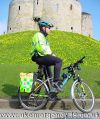
TENYAS’s life-cycle with the historic Clifford’s Tower in the background.
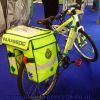
This is one of London Ambulance Service’s cycle response units. The large yellow pannier pack opens to allow two bags of medical equipment to be removed and carried to the patient. Notice the map pocket integrated into the lid. The LAS cycle unit concentrates on attending category B and C calls in place of an ambulance.

This is the third TENYAS life cycle. New in May 2003, this yellow bike is fitted with two white and two blue flashing lights, a siren and panniers of medical equipment and was bought with a generous donation from the Rotary Club. It is used to answer 999 calls as a rapid response unit in the narrow, winding streets of York. The front suspension on the cycle is great on rough terrain, but wastes the rider’s energy moving up and down when pedalling hard on roads. Hence a small switch on the handlebar can be flicked which locks the suspension in position, disabling it and allowing the bike to act as though it is not fitted with suspension.

The third life cycle in use!
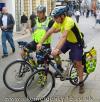
A meeting of cycling emergency services personnel. A TENYAS paramedic and a North Yorks. police constable stop briefly in York city centre. Both community-oriented schemes have been phenomenal successes and have been duplicated up and down the country.

This picture shows from left to right: paramedics Mark Inman (life-cycle rider), Simon Marshall (assistant life-cycle project manager) and Paul Brown (life-cycle project manager). They are preparing for a challenge involving racing around a track and attending to simulated casualties at a cycle event.

The challenge in progress! Paramedic Paul Brown is applying a bandage to a casulaty before continuing on to complete another lap of the course.

TENYAS’s life-cycle was started in May 2001. LAS (London Ambulance Service) were the first service to trial a cycling paramedic a year and a half earlier. But does this photograph show that cycling paramedics have been around for much longer than first thought?
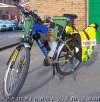
One of the two TENYAS Lifecycles outside York ambulance station in October 2001.

This is TENYAS’s life cycle in use. It is a top of the range mountain bike fitted with white lights, blue flashing lights (shown) and a siren, alongside two panniers of medical equipment. Ambulance control have just notified us of an emergency by mobile ‘phone.




















